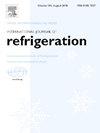Advanced M-Cycle System for Simultaneous Cooling and Water Desalination
IF 3.5
2区 工程技术
Q1 ENGINEERING, MECHANICAL
International Journal of Refrigeration-revue Internationale Du Froid
Pub Date : 2025-03-10
DOI:10.1016/j.ijrefrig.2025.03.015
引用次数: 0
Abstract
Access to safe drinking water and a healthy living environment is essential for human survival. With growing populations and decreasing availability of potable water, producing safe water from non-drinkable sources has become increasingly important. One effective method to achieve this is through water desalination. Among desalination techniques, humidification and dehumidification stand out as simple, low-cost, and portable solutions that do not require advanced equipment. These systems can be integrated with other technologies to fulfill multiple needs. One such integration involves air conditioning systems, where the innovative M-cycle concept has shown great promise. This cycle can cool air to its dew point without humidification and without using environmentally harmful refrigerants – essentially, water acts as the working fluid.
In this study, an M-cycle-based cooler has been creatively modified to generate fresh water alongside cooling the air, serving both desalination and air conditioning purposes. A comprehensive mathematical model has been developed and solved using finite element methods. The system's heat and mass exchanger has been optimized, and two configurations for its operation have been proposed. A new performance metric, PR (Performance Ratio), has been introduced to assess the system's dual-function efficiency.
Results indicate that an infiltration rate of 0.3 yields the highest water distillation rate and optimal cooling performance. The proposed design achieves a 9.2% higher gain-output ratio compared to conventional humidification-based desalination systems and offers 50% more cooling capacity than standard M-cycle air conditioning units, while demonstrating up to 8 times greater energy efficiency for desalination.

求助全文
约1分钟内获得全文
求助全文
来源期刊
CiteScore
7.30
自引率
12.80%
发文量
363
审稿时长
3.7 months
期刊介绍:
The International Journal of Refrigeration is published for the International Institute of Refrigeration (IIR) by Elsevier. It is essential reading for all those wishing to keep abreast of research and industrial news in refrigeration, air conditioning and associated fields. This is particularly important in these times of rapid introduction of alternative refrigerants and the emergence of new technology. The journal has published special issues on alternative refrigerants and novel topics in the field of boiling, condensation, heat pumps, food refrigeration, carbon dioxide, ammonia, hydrocarbons, magnetic refrigeration at room temperature, sorptive cooling, phase change materials and slurries, ejector technology, compressors, and solar cooling.
As well as original research papers the International Journal of Refrigeration also includes review articles, papers presented at IIR conferences, short reports and letters describing preliminary results and experimental details, and letters to the Editor on recent areas of discussion and controversy. Other features include forthcoming events, conference reports and book reviews.
Papers are published in either English or French with the IIR news section in both languages.

 求助内容:
求助内容: 应助结果提醒方式:
应助结果提醒方式:


